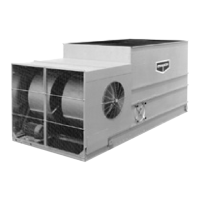22
Operation and Maintenance Instructions
Capacity Control Methods for Cold Weather Operation
Induced draft and forced draft cooling towers require separate guidelines for capacity control during cold weather operation.
The sequence of control for a cooling tower operating at low ambient conditions is much the same as a cooling tower operating
under summer conditions provided that the ambient temperature is above freezing. When the ambient temperatures are below
freezing, additional precautions must be taken to avoid the potential for damaging ice formation or equipment damage.
It is very important to maintain close control of the cooling tower during winter operation. EVAPCO recommends that an absolute
MINIMUM leaving water temperature of 42° F must be maintained; obviously, the higher the water temperature from the tower, the
lower the potential for ice formation. This assumes that proper water flow over the tower is maintained.
Induced Draft Unit Capacity Control
The simplest method of capacity control is cycling the fan motor on and off in response to the leaving water temperature of
the tower. However, this method of control results in larger temperature differentials and longer periods of down time. During
extremely low ambient conditions, the moist air may condense and freeze on the fan drive system. Therefore, fans must
be cycled during extremely low ambient conditions to avoid long periods of idle time whether water is flowing over
the fill or in bypass. The number of start/stop cycles must be limited to no more than six per hour.
A better method of control is the use of two speed fan motors. This allows an additional step of capacity control. This
additional step reduces the water temperature differential, and therefore, the amount of time the fans are off. In addition, two
speed motors provide savings in energy costs, since the tower has the potential to operate on low speed for the reduced
load requirements.
The best method of capacity control during cold weather operation is the use of a variable frequency drive (VFD). This
allows the closest control of the leaving water temperature by allowing the fan(s) to run at the appropriate speed to closely
match the building load. As the building load decreases, the VFD control system may operate for long periods of time at fan
speeds below 50 percent. Operating a low leaving water temperature and low air velocity through the unit can cause ice to
form. It is recommended that the minimum speed of the VFD be set at 50 percent of full speed to minimize the potential for
ice to form in the unit. Space heaters in the motors are suggested to help keep the high humidity air from condensing in the
motors during idle periods.
Forced Draft Unit Capacity Control
The most common methods of capacity control are cycling the single speed fan motors, using two speed motors or pony
motors and utilizing variable frequency drives to control the tower fans. Although capacity control methods for forced draft
units are similar to those used for induced draft units, there are slight variations.
The simplest method of capacity control for forced draft units is to cycle the fan(s) on and off. However, this method of
control results in larger temperature differentials and periods of time with the fans off. When the fans are cycled off, the
water falling through the unit can draw air flow into the fan section. During extremely low ambient conditions, this moist air
may condense and freeze on the cold components of the drive system. When conditions change and cooling is needed, any
amount of ice that has formed on the drive system can severely damage the fans and fan shafts. Therefore, fans MUST be
cycled during low ambient operation to avoid long periods of idle fan operation. Excessive cycling can damage the
fan motors; limit the number of cycles to a maximum of six per hour.
Two speed or pony motors offer a better method of control. This additional step of capacity control will reduce water
temperature differentials and the amount of time that the fans are off. This method of capacity control has proven effective
for applications where load variations are excessive and cold weather conditions are moderate.
The use of a variable frequency drive provides the most flexible method of capacity control for forced draft units. The VFD
control system allows the fans to run at nearly an infinite range of speeds to match the unit capacity to the system load.
During periods of reduced load and low ambient temperatures, the fans can be maintained at a minimum speed which will
ensure a positive air flow through the unit. This positive air flow in the unit will prevent moist air from migrating towards the
cold fan drive components reducing the potential for condensation to form and freeze on them. The VFD control system
should be implemented for applications that experience fluctuating loads and severe cold weather conditions.

